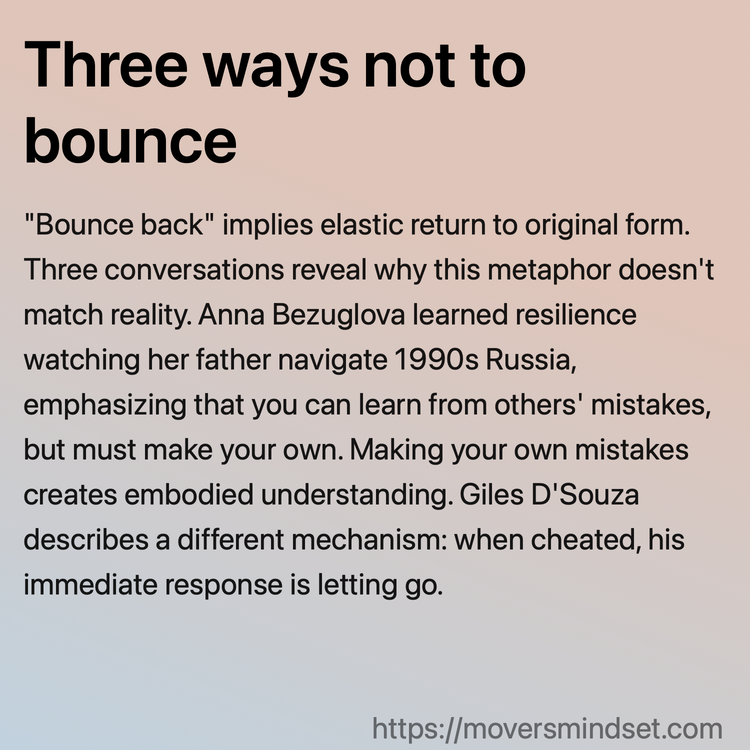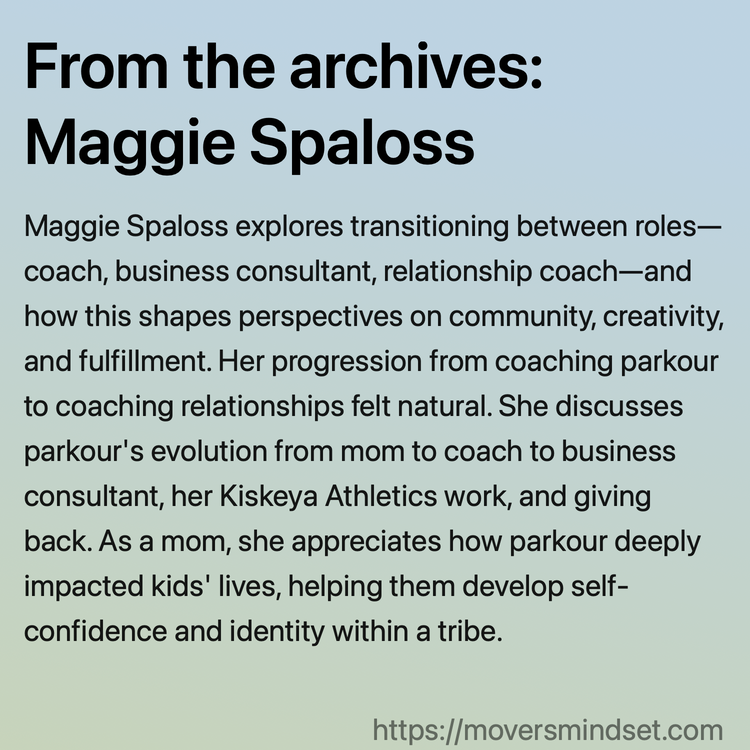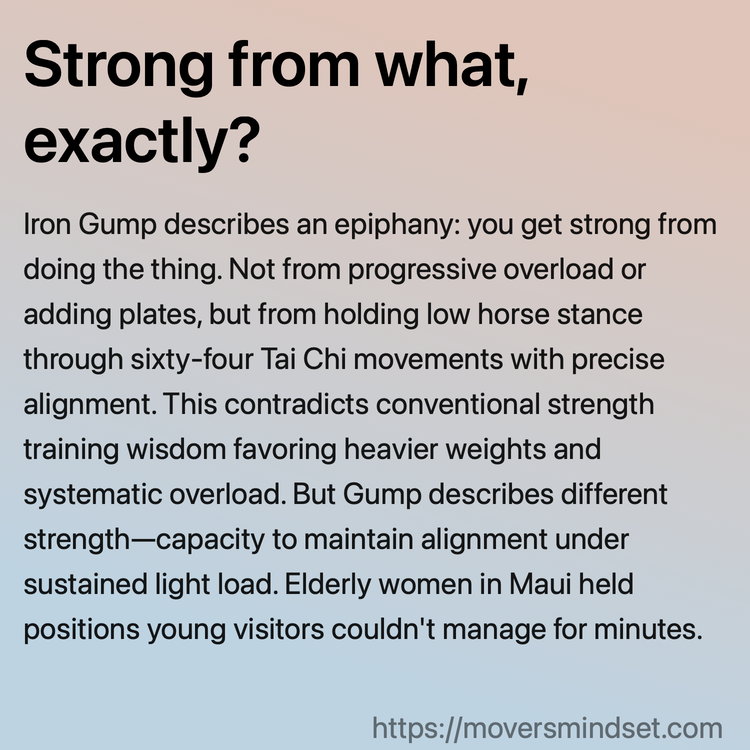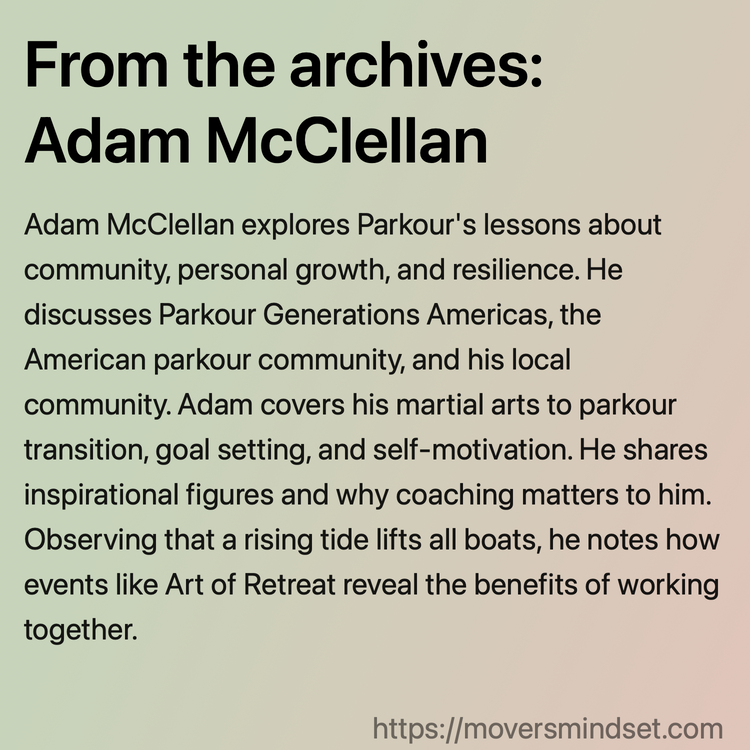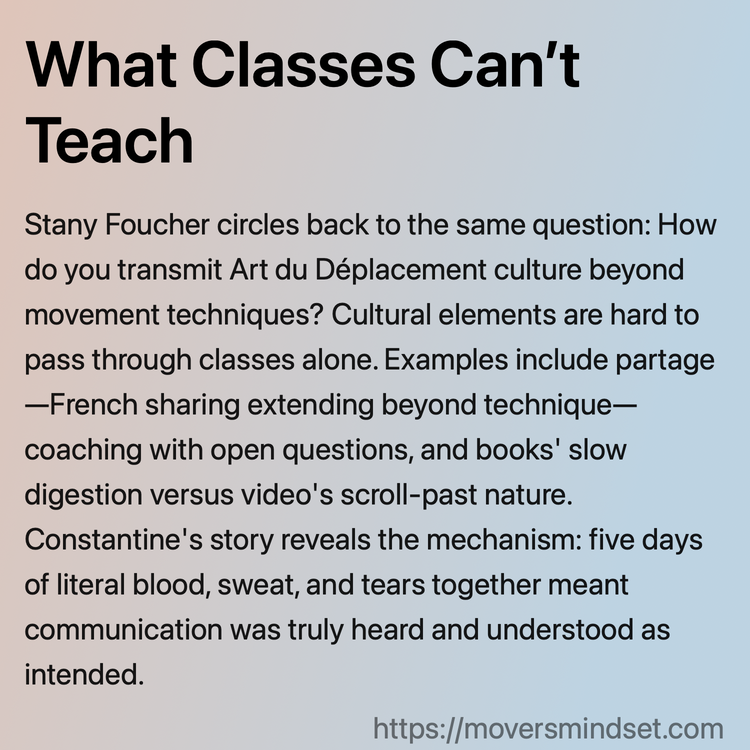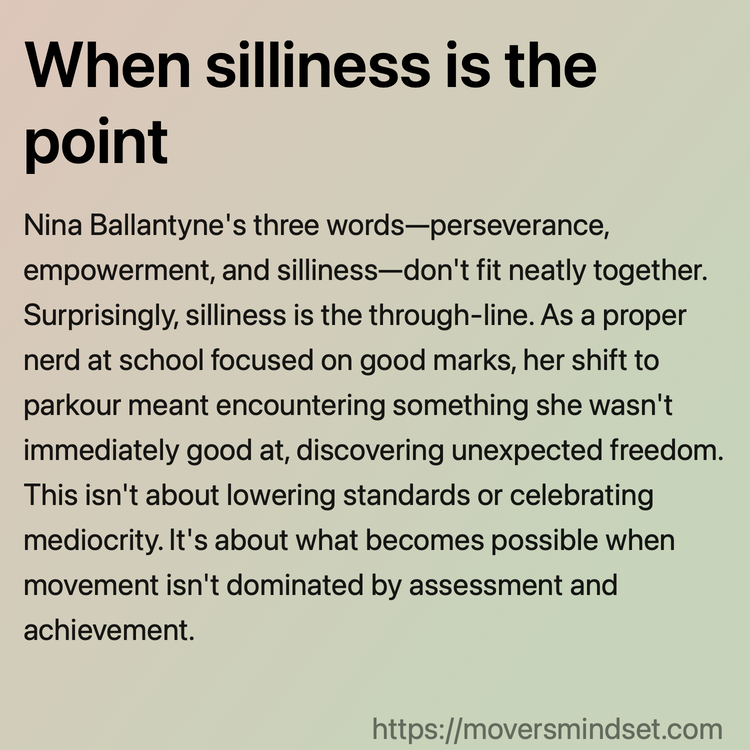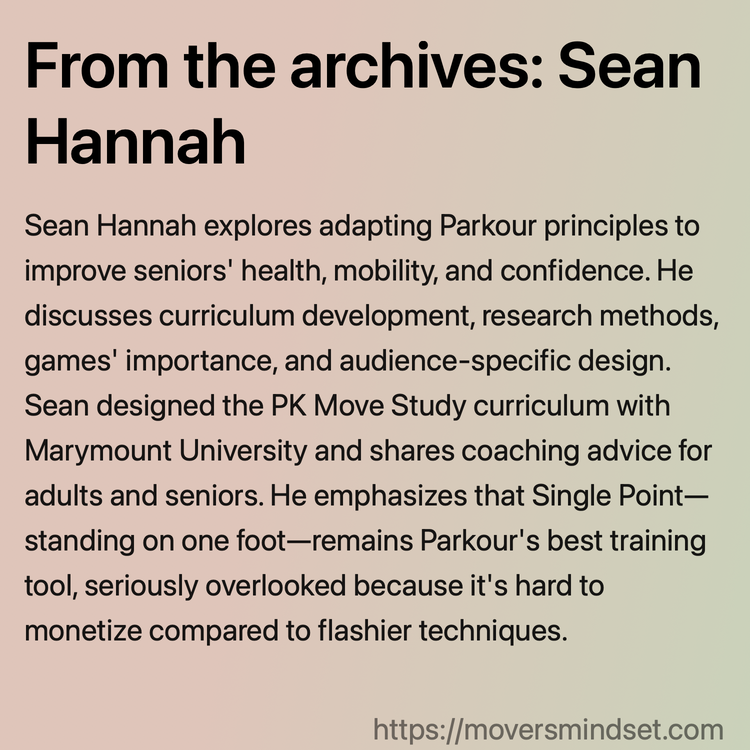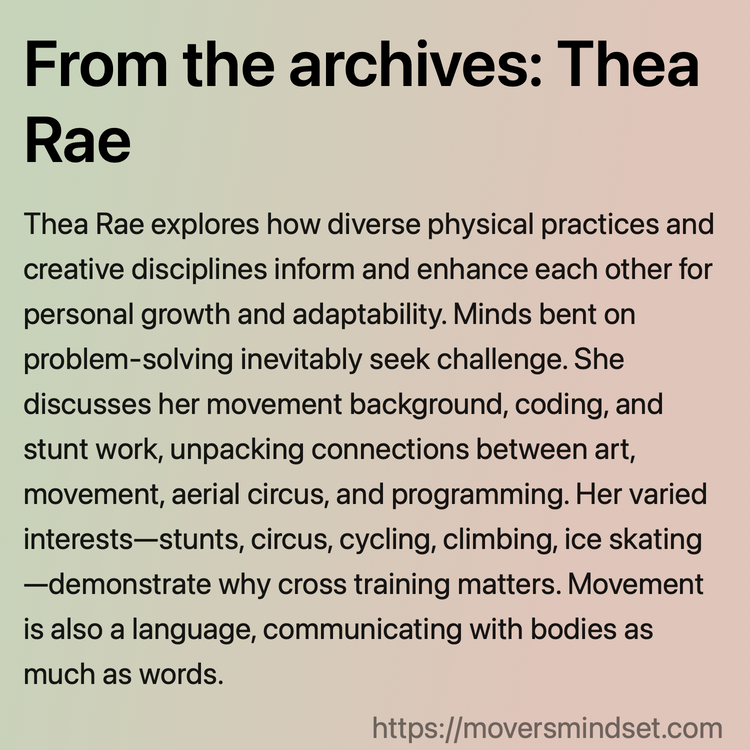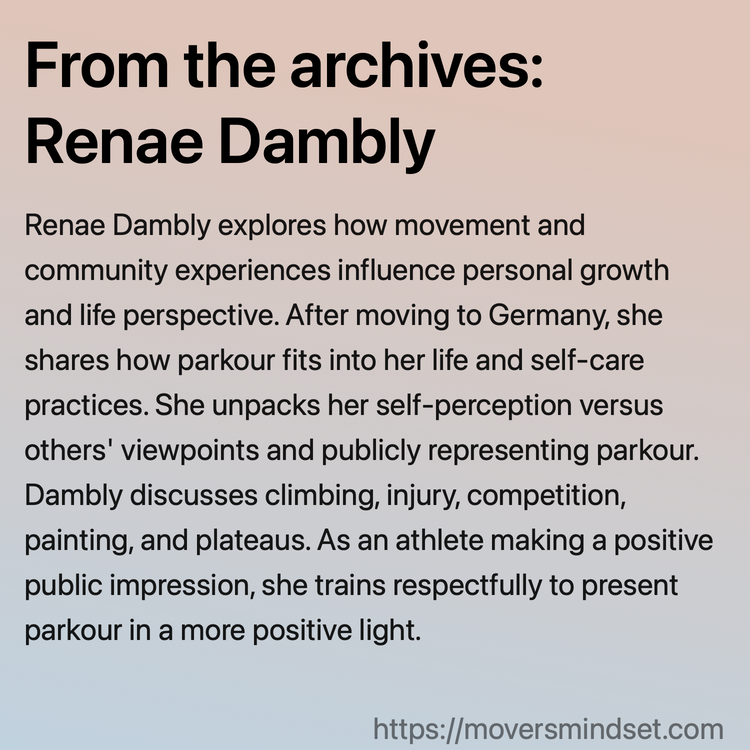Craig Constantine
Three ways not to bounce
“Bounce back” implies elastic return to original form. Three conversations reveal why this metaphor doesn’t match reality. Anna Bezuglova learned resilience watching her father navigate 1990s Russia, emphasizing that you can learn from others’ mistakes, but must make your own. Making your own mistakes creates embodied understanding. Giles D’Souza describes a different mechanism: when cheated,… more →
From the archives: Maggie Spaloss
Maggie Spaloss explores transitioning between roles—coach, business consultant, relationship coach—and how this shapes perspectives on community, creativity, and fulfillment. Her progression from coaching parkour to coaching relationships felt natural. She discusses parkour’s evolution from mom to coach to business consultant, her Kiskeya Athletics work, and giving back. As a mom, she appreciates how parkour deeply… more →
Strong from what, exactly?
Iron Gump describes an epiphany: you get strong from doing the thing. Not from progressive overload or adding plates, but from holding low horse stance through sixty-four Tai Chi movements with precise alignment. This contradicts conventional strength training wisdom favoring heavier weights and systematic overload. But Gump describes different strength—capacity to maintain alignment under sustained… more →
In-between-isode with Craig Constantine
Hello, Craig here. This isn’t a regular Movers Mindset episode — it’s just me for a quick check-in, and a few invitations you might find interesting. First up, I’m introducing a way to support Movers Mindset through voluntary patronage. The podcast has always been freely available, and it always will be. But if you’d like more →
From the archives: Adam McClellan
Adam McClellan explores Parkour’s lessons about community, personal growth, and resilience. He discusses Parkour Generations Americas, the American parkour community, and his local community. Adam covers his martial arts to parkour transition, goal setting, and self-motivation. He shares inspirational figures and why coaching matters to him. Observing that a rising tide lifts all boats, he… more →
What Classes Can’t Teach
Stany Foucher circles back to the same question: How do you transmit Art du Déplacement culture beyond movement techniques? Cultural elements are hard to pass through classes alone. Examples include partage—French sharing extending beyond technique—coaching with open questions, and books’ slow digestion versus video’s scroll-past nature. Constantine’s story reveals the mechanism: five days of literal… more →
The part we don’t talk about
Julie Angel describes her practice as emotional, interesting, and joyful. While most movement talk centers on muscles, tendons, and range of motion, her focus is elsewhere: movement is emotional and connected. This frames biomechanics and force production as valid but fundamentally incomplete. Stripping emotion from movement discourse loses everything determining whether someone actually moves. Angel… more →
When silliness is the point
Nina Ballantyne’s three words—perseverance, empowerment, and silliness—don’t fit neatly together. Surprisingly, silliness is the through-line. As a proper nerd at school focused on good marks, her shift to parkour meant encountering something she wasn’t immediately good at, discovering unexpected freedom. This isn’t about lowering standards or celebrating mediocrity. It’s about what becomes possible when movement… more →
From the archives: Tyson Cecka
Tyson Cecka explores what drives creating and refining parkour spaces and objects, and how personal and communal experiences influence this process. He unpacks his design process for building obstacles, where he finds inspiration, and why he doesn’t consider himself a great artist. Tyson shares experiences with depression and how it’s affected his life. He emphasizes… more →
From the archives: Sean Hannah
Sean Hannah explores adapting Parkour principles to improve seniors’ health, mobility, and confidence. He discusses curriculum development, research methods, games’ importance, and audience-specific design. Sean designed the PK Move Study curriculum with Marymount University and shares coaching advice for adults and seniors. He emphasizes that Single Point—standing on one foot—remains Parkour’s best training tool, seriously… more →
From the archives: Thea Rae
Thea Rae explores how diverse physical practices and creative disciplines inform and enhance each other for personal growth and adaptability. Minds bent on problem-solving inevitably seek challenge. She discusses her movement background, coding, and stunt work, unpacking connections between art, movement, aerial circus, and programming. Her varied interests—stunts, circus, cycling, climbing, ice skating—demonstrate why cross… more →
From the archives: Renae Dambly
Renae Dambly explores how movement and community experiences influence personal growth and life perspective. After moving to Germany, she shares how parkour fits into her life and self-care practices. She unpacks her self-perception versus others’ viewpoints and publicly representing parkour. Dambly discusses climbing, injury, competition, painting, and plateaus. As an athlete making a positive public… more →
